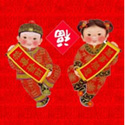You are invited to a new year’s party – Chinese style. The 2002 Chinese Lunar New Year Party will be Saturday, Feb. 16, from 6 to 11 p.m. at the UNMC Student Life Center, 3908 Jones St. The event is co-sponsored by the UNMC International Studies and Programs, Chinese Student and Scholar Associations at UNMC, University of Nebraska at Omaha and Creighton University, and the Omaha Chinese Professional Association. 
The party is open to the public and amenable to the whole family, including children. There will be original Chinese foods, karaoke singing, games and popular music for ballroom style dancing. The festivities will begin in the gymnasium with a catered Chinese dinner, followed by a short program featuring several speakers (with Chinese/English interpretation) and a presentation by children from Omaha Chinese school, followed by dancing to Chinese popular music. There will be a separate room for karaoke singing and a third room for ping-pong and other games.
Anyone who plans to eat dinner is required to purchase their tickets in advance to insure adequate meal preparation. The deadline to purchase dinner tickets is Wednesday, Feb. 13, by 6 p.m. There will be a limited number of additional dinners available for people who purchase tickets on the day of the party, but they will be distributed on a first-come, first-served basis. Advanced tickets are $6 per adult non-student and escort, $4 for students, escorts and children over 10, and $2 for children under 10. On the evening of the celebration, all ticket prices will increase by $1.
The actual day of this year’s Chinese New Year is Tuesday, Feb. 12. The New Year doesn’t fall on the same date each year, although it is always in January or February. Today, there are Chinese New Year celebrations around the world. In Japan, Korea and Vietnam, for example, celebrations are known as Lunar New Year or the Spring Festival. At one point in Chinese history, the current emperor designated the start of the New Year. Contemporary celebrations are based on Emperor Han Wu Di’s almanac. It uses the first day of the first month of the Lunar Year as the start of Chinese New Year.
Past and Present
Legend tells of a village in China, thousands of years ago that was ravaged by an evil monster one winter’s eve. The following year the monster returned and again ravaged the village. Before it could happen again, the villagers devised a plan to scare the monster away. Red banners were hung everywhere – the color red has long been believed to protect against evil. Firecrackers, drums and
gongs were used to create loud noises to scare away the beast. The plan worked and the celebration lasted several days as people visited, exchanged gifts, danced and ate tasty treats. 
Celebrations today are both literal and symbolic. Spring-cleaning is started about a month prior to the New Year and must be completed before the celebrations begin. Typically, red packets with money are given as symbols of good luck. The amount is usually an even number as odd numbers are regarded as unlucky. Lions are considered to be good omens. The lion dance is believed to repel demons. Each lion has two dancers, one to maneuver the head, the other the back. During the New Year celebration, people try not to fight or be mean to each other, as this will bring an unlucky year.
Symbolism of Food
Foods consumed during the holiday are symbolic, as well. Typically, red meat is not served and people are careful not to serve or eat from a chipped or cracked plate. Fish is eaten to ensure long life and good fortune. Red dates bring the hope for prosperity, melon seeds for proliferation and lotus seeds means the family will prosper. Oranges and tangerines symbolize wealth and good fortune. Nian gao, a specially prepared rice cake, is always served during the celebration. It is believed the higher the cake rises, the better the year will be. When guests drop by, a “prosperity tray” is served. The tray has eight sides (another symbol of prosperity) and is filled with goodies like red dates, melon seeds, cookies and New Year cake. [Material for this Chinese New Year history was taken from www.web.holidays.com/lunar.]
Where to Go
Tickets for the Feb. 16 Chinese Lunar New Year Party may be purchased from the following sources:
- UNMC: Xinying Li, 559-4884; Xiaoguang Luo, 559-4035; Benjamin Xie, 559-3377; Zhenggang Pan, 559-7753; Steve Daubendiek, 559-6414.
- UNO: Zheng Liu, 402-215-8315
- Creighton University: Hui Shen, 280-4996.
- Omaha Chinese School, located at Millard Public Library, Saturday, Feb. 9, 2:15 to 4:30 p.m. John Chen, 618-7863.
For more information, contact Daubendiek or the office of International Studies and Programs at 559-2924.